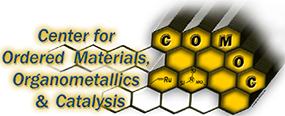Catalysis
Catalysis acts as the keystone of the modern industrial chemistry, because approximately 90% of all industrial reactions occur catalytically. Therefore, catalysts can be considered as the driving force (rate) and the driving wheel (selectivity) of chemical industrial processes. Nowadays, there is an increasing tendency to heterogenize actual homogenous catalytic systems. Ordered mesoporous materials open up new opportunities in this field of green and sustainable chemistry, and this for two main raisons: the high surface area and large pore volume provides a high number of catalytically active sites available for catalytic reaction and, secondly, the catalyst can be easily regenerated from the reaction mixture by filtration after the catalytic cycle.

Ordered Mesoporous Silicas
Model based design of acid base synergetic catalysts for aldol condensations
Researcher: drs Jeroen Lauwaert
(In collaboration with the research group of Prof. Dr. Ir. J. Thybaut (Ugent S5, Chemical Engineering department)
The use of heterogeneous catalysts has many advantages with respect to homogeneous catalysts, such as an easy separation of the catalyst from the reaction products and a possibility of tuning the product yields on the basis of shape-selectivity. One aspect that recently gains more and more attention is that heterogeneous catalysts allow us to incorporate different kinds of active sites that could not be combined in homogeneous catalysis, such as a combination of both acid and base sites. Aldol condensations are reactions that can be catalyzed by either an acid or a base and recent literature describes that a combination of both types of active
In this study, SBA-15 is chosen as support material for the catalytic functions. SBA-15 is a mesoporous silica with a high specific surface area (± 750 m²/g), a hexagonal pore structure, thick and strong pore walls and a narrow pore size distribution that is tunable from 5 up to 30 nm. On the surface of this material we have silanol groups (Si-OH) which can be exchanged for other more interesting groups by means of a grafting procedure. In this work, different types of basic functions (primary amines, secondary aliphatic amines, secondary aromatic amines, tertiary amines, …) and acid functions (sulfonic acids and carboxylic acids) are grafted onto the mesoporous silica.
All these catalysts will be used in aldol condensation 
Periodic Mesoporous Organosilicas
Sulfur and nitrogen functionalized ethene PMO materials as a solid acid catalyst
Researcher: Els.DeCanck [at] ugent.be (drs Els De Canck)
Oxidizing the sulfur group results into a sulfonic acid functionality which provides an excellent way to create a solid acid catalyst. Amine groups on the other hand are good base catalyst and combining an amine and sulfonic acid group provides us with a bifunctional catalyst which is from an economic point of view extremely interesting. This catalyst is tested for an aldolcondensation, e.g. the reaction of acetone with nitrobenzaldehyde. Testing of the catalysts will occur in collaboration with the research group of Prof. Dr. Ir. J. Thybaut (Ugent S5, Chemical Engineering department).

A master thesis subject for these materials can be found here.
Diels Alder Adducts on ethenylene bridged Periodic Mesoporous Organosilicas: creating completely new functionalities for adsorption, catalysis and chromatography.
Researcher: dr Maria Dolores Esquivel Merino

Periodic Mesoporous Organosilicas or commonly named PMOs, are hybrid materials with ordered mesostructures, high surface areas (around 1000 m2 g-1) and narrow pore size distribution. Although one of the most promising aspects of PMOs is the opportunity to modify and functionalize the organic bridges in its framework to create functionalities, to date, examples of true organic C-C reactions are very scarce. For that reason, this research attempts to incorporate new surface functional groups through Diels-Alder cycloadditions between ethenylene bridges of an ethane-PMO (e-PMO) with commercial dienes. The great versatility of this organic reaction opens new opportunities for obtaining new materials by using the appropriate reactants which act as dienes. The new functionalities incorporated into the pores of the e-PMO will give rise to materials with promising properties in catalysis, adsorption or chromatography.
In catalysis, PMO material with pendant amino groups (P-e-PMO) will be tested in aldol condensations. In this catalyst, the amino groups are not connected directly to the silicon atoms, and therefore, these groups are very stable towards hydrolysis. Respect of tetrazine modified PMO materials would be very suited to anchor several complexes in a very firm and robust way to highly selective catalysts.
A master thesis subject for these materials can be found here.
Ordered Mesoporous Polymers
A new stable support for catalysis.
Researchers: Ilke.Muylaert [at] ugent.be (drs Ilke Muylaert) and drs Jeroen De decker
Due to the inherent porosity and the presence of hydroxyl functionalities in their framework, the polymers are ideal as support for the immobilization of catalytic active species, like metals, metal oxides, metal complexes, acid and/or basic groups, …
Immobilization of Manganese Salen complex on surface of mesoporous phenolic resin
In COMOC, the mesoporous phenolic resins are functionalized with titanium and vanadium oxide and have been evaluated as catalyst for the oxidation of cyclohexene. Next, sulfonic acid groups are introduced in the aromatic framework and a stable sulfonic acid catalyst for esterification reaction is developped. Finally, a chiral manganese salen catalyst is immobilized on the surface. Here, an highly active catalyst for the chiral epoxidation is obtained.
Metal Organic Frameworks:
Nano-scale reactors
Researcher: Thomas.Bogaerts [at] ugent.be (Thomas Bogaerts)
Metal organic frameworks (MOFs) are crystalline, porous materials that consist of metal building blocks connected with organic linkers. The connectivity is driven by coordinative chemistry between the metal centers and a functional group of the linker. An attractive property of this type of materials is their tunability. The whole organic toolbox can 
MOFs can exist in different three-dimensional structures; they can consist of a number of stacked layers, long straight pores or large cages connected by small windows. These geometrical properties can be used to design advanced materials that can surpass the possibilities of the ‘basic’ MOF. A way to achieve this is to use the large cages to trap a guest molecule that can be used as a catalyst. Since the cage size can go up to 30 angstroms in diameter large homogeneous complexes can be heterogenized without the need for any covalent grafting.
Using this encapsulation procedure, well-known homogeneous catalysts such as the salen complex can be encapsulated inside a solid material. This allows using MOFs for enantioselective catalysis without the need for expensive building blocks. Moreover, the known properties of an existing homogeneous catalyst are transferred to the MOF.
A master thesis subject for these materials can be found here. (link to Design of ship-in-a-bottle nanoreactors/catalysts for the selective transformations of fine chemicals.)
Synthesis and characterization of vanadium containing metal-organic frameworks (MOFs) for gas adsorption and heterogeneous catalytic applications.
Research: dr Shyam Biswas
The high porosity, moderate thermal stability, easy tenability of pore surface, high density of catalytically active metal sites and insolubility in common organic solvents have enabled metal-organic frameworks (MOFs) as promising candidates for gas adsorption and heterogeneous catalytic applications. The development of MOFs for catalytic applications is still at its early stage. We have chosen vanadium as a framework node because of its redox activity. The resulting MOFs thus can be used as catalysts in redox reactions. As a proof of concept, we have shown that the vanadium based metal-organic framework MIL-47 acts as a low-leaching catalyst in the oxidation of cyclohexene [Leus et al., J. Catal. 2012, 285, 196-207]. We have also reported the synthesis and heterogeneous catalytic activity of a vanadium 2,6-naphthalenedicarboxylate denoted as COMOC-3 (COMOC = Center for Ordered Materials, Organometallics and Catalysis, Ghent University) in cyclohexene oxidation [Liu et al., Eur. J. Inorg. Chem. 2011, doi: 10.1002/ejic.201101099].
Scheme 1. Functionalized organic linkers for MOF synthesis.
In this project, synthesis of vanadium based MOFs, which are structurally related to known MOFs with trivalent metal (Cr, Al, Fe, Ga, In) ions and polytopic carboxylate linkers, will be targeted. Moreover, already existing vanadium containing MOFs with different pre-functionalized linkers (Scheme 1) will be prepared in order to evaluate the effect of such organic functional groups in catalysis and adsorption. Several characterization techniques such as X-ray powder diffraction (XRPD), thermogravimetric, diffuse reflectance infrared Fourier transform (DRIFT), nitrogen sorption and elemental analysis will be employed. Several collaboration partners all over Europe (high pressure gas adsorption: Free University of Brussels, XRPD: Augsburg University, Catalysis: Leipzig University and Delft University of Technology) are involved in this project. So far, I have been successful in preparing vanadium based non- and amino-functionalized MIL-101 (Figure 1; Biswas et al., Eur. J. Inorg. Chem. 2012, doi: 10.1002/ejic.201200106) which exhibits high uptakes of nitrogen and carbon dioxide.
Figure 1. Nitrogen sorption analysis of V-MIL-101 and V-MIL-101-NH2. In the inset, the MTN topological framework of V-MIL-101 is shown, highlighting the supertetrahedral building units.
Isoreticular Metal-Organic Frameworks (MOFs): synthesis, characterization and applications
Researcher: YingYa.Liu [at] ugent.be (dr Ying Ya Liu)
MOFs are crystalline materials constructed by linking multidentate ligands with metal/cluster nodes to form infinite networks. By choosing the right building bricks, we aim to design a series of bimetallic porous MOFs bearing a precise control over morphology, pore size that can accommodate various guest molecules. Furthermore, by using the functionalized linker in the walls of the framework, catalytically active metal-connecting points or other functional groups can be incorporated into porous MOFs, to realize the applications in heterogeneous catalysis.
Scheme 1 Schematic representation of isoreticular MOFs with different linkers
A master thesis subject for these materials can be found here.
Synthesis of MIL-47 isoreticular structures with applications in catalysis.
Researcher: Karen.Leus [at] ugent.be (drs Karen Leus)
This PhD research is mainly focussed on the synthesis of MIL-47 and it’s catalytic performance in the oxidation of cyclohexene. In a first stage, TBHP in water was used as oxidant [1]. However, significant leaching of the V centers were observed. The use of TBHP in decane, increased the stability of the MOF structure and decreased the amount of leached V (towards zero leaching) [2].
[1]K. Leus et al, Chemical Communications, 2010, 46,5058-5087
[2]K. Leus and M. Vandichel et al., Journal of Catalysis, 2012, 285-196-207
[3]K. Leus et al, Langmuir, 2012, submitted.








